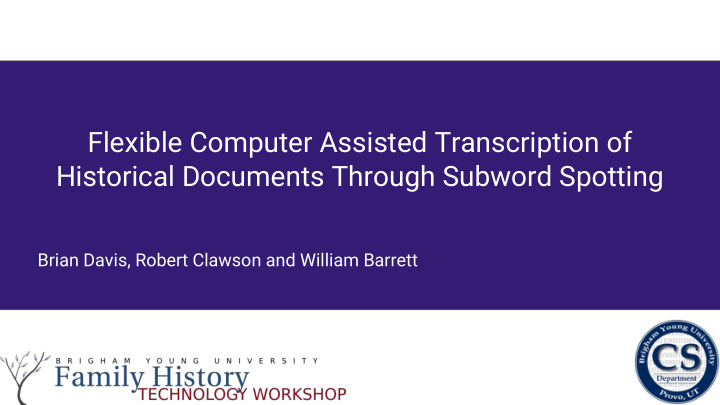



Flexible Computer Assisted Transcription of Historical Documents Through Subword Spotting Brian Davis, Robert Clawson and William Barrett
What if…? Effective crowdsourced transcription of documents via - Smartphone users - Only a few minutes at a time
What if…? Effective crowdsourced transcription of documents via - Smartphone users - Only a few minutes at a time
What if…? Effective crowdsourced transcription of documents via - Smartphone users - Only a few minutes at a time
What if…? Effective crowdsourced transcription of documents via - Smartphone users - Only a few minutes at a time http://telecoms.com/463552/global-smartphone-market-q4-2015-peak-smartphone-approaches/
Computer Assisted Transcription (CAT) Why not do it all manually? Why not do it automatically?
Prefix Based CAT User makes correction to automatic transcription, approving all previous content. Recognition algorithm makes new prediction for remaining text. Requires sequential text. Image of Toselli et al’s online demo A. Toselli, V. Romero, M. Pastor, , and E. Vidal, “Multimodal interactive transcription of text images,” Pattern Recognition, vol. 43, no. 5, pp. 1814–1825, 2010. N. Serrano, A. Gimenez, J. Civera, A. Sanchis, and A. Juan, “Interactive handwriting recognition with limited user effort,”IJDAR, vol. 17, no. 1, pp. 47–59, 2014.
CAT Through Word Spotting Find words that look the same and label them the same. Zagoris et al (2015) use a relevance feedback loop to learn from every correct match the user selects. K. Zagoris, I. Pratikakis, and B. Gatos, “A framework for efficient transcription of historical documents using keyword spotting,” in Proc. HIP. ACM, 2015.
CAT Through Word Spotting Find words that look the same and label them the same. Robert Clawson’s Intelligent Indexing (2014) relies on user filtering of matches. R. Clawson, “Intelligent indexing: A semi-automated, trainable system for field labeling,” Master’s thesis, Brigham Young University, 2014. [Online]. Available: scholarsarchive.byu.edu/etd/5307/
CAT Through User Supervised OCR Neudecker and Tzadok (2010) OCR, then present characters with low score to user to clean. C. Neudecker and A. Tzadok, “User collaboration for improving access to historical texts,” Liber Quarterly, vol. 20, no. 1, p. 119-128, 2010.
Strengths of Prior CAT Systems OCR & word spotting: - As long as words/letters can be segmented, will work with any document OCR: - Simple user tasks (no typing, very fast) - Very parallelizable Word spotting: - Potential high payoff for little user effort (few taps, many words transcribed)
Weaknesses of Prior CAT Systems Prefix based: - Only works on sentence structured writing. - Limited lexicon size (e.g. hard time with names). Word spotting: - Often words don’t repeat frequently or at all (e.g. names). OCR: - Letter segmentation improbable for handwritten text.
A Solution Solution: Spot character n-grams (bigrams and trigrams). Reconstruct words from them.
The “Sweet Spot” Bigrams/trigrams occur with great frequency + Subword spotting still reasonably accurate = High pay-off for spotting effort http://machinedesign.com/archive/building-better-bat Additionally, able to use larger lexicon, including more names.
N-gram Spotting and Word Completion _ _ c h a e l
N-gram Spotting and Word Completion M i c h a e l
N-gram Spotting and Word Completion _ _ _ h o _ _
N-gram Spotting and Word Completion A n _ h o _ _
N-gram Spotting and Word Completion A n t h o _ _
N-gram Spotting and Word Completion A n t h o n y Computers are much better at this than we are! A n _ h o _ _ => [anchors, anchovy, anthony, anthoni]
N-gram Spotting and Word Completion Regular expression make this easy. Spotted n-grams are parsed into a regular expression. The regular expression is used as a lookup on the lexicon.
Overview of Proposed CAT System
Proposed CAT System
Proposed CAT System
Proposed CAT System
Proposed CAT System
Proposed CAT System
Proposed CAT System
Proposed CAT System
Proposed CAT System
Proposed CAT System
Proposed CAT System
Proposed CAT System
Proposed CAT System
Overview of Proposed CAT System Complicated system, simple UI
Mock-up of User Tasks
Mock-up of User Tasks
Justification: Simulation of Proposed CAT System George Washington corpus 100 most common bigrams simulated 50% recall* for bigram spotting simulated uncertain number of characters not spotted in word word was “transcribed” when 10 or less possible transcriptions remain lexicon of ~108,000 words and ~7, 000 names *Based on preliminary results in subword spotting.
Possible Bonuses N-gram spotting verification may be reasonably completed by non-native speakers of a language. Small user tasks may be easy to gamify.
Questions?
Limitations and Weaknesses Dependent on word segmentation. May require manual transcription for first few pages of a corpus as training. Requires manual transcription to “finish” out-of-vocabulary, malformed and infrequent unfavorable words. Poor spotting will burden human users with too much rejecting (or low recall). If recognition/spotting scoring of word images does not prune effectively, the feasible lexicon size may be limited.
Subword N-gram Spotting Preliminary results show 64% mAP for bigrams and 72% mAP for trigrams on George Washington dataset. * Better results should come with a specialized method. *using adaption of J. Almazan, A. Gordo, A. Fornes, and E. Valveny, “Word spotting and recognition with embedded attributes,” IEEE Transactions on Pattern Analysis and Machine Intelligence, vol. 36, no. 12, pp. 2552–2566, 2014.
Recommend
More recommend